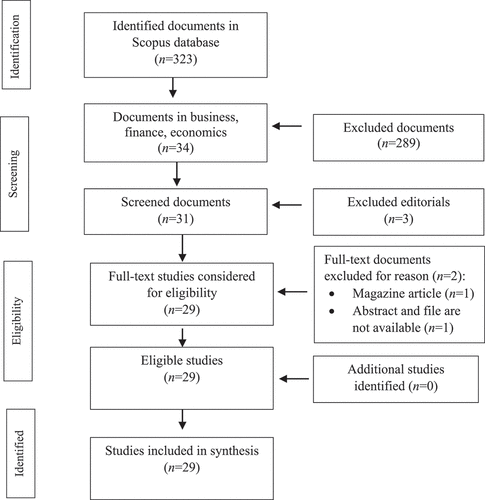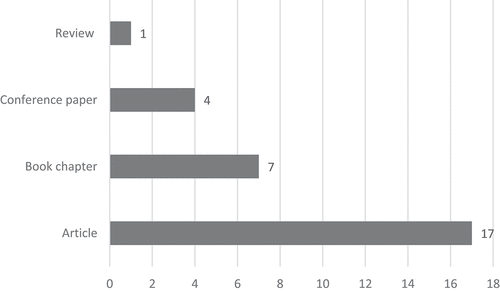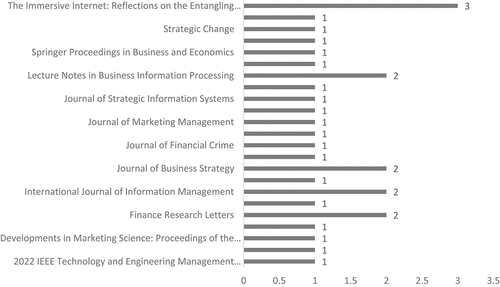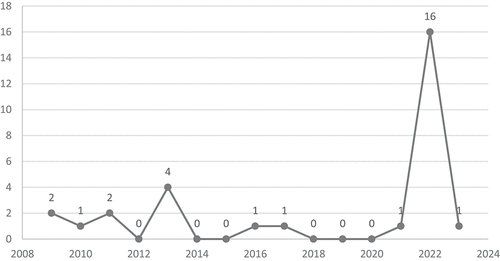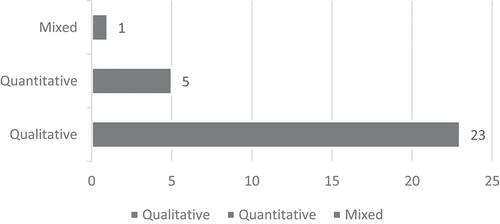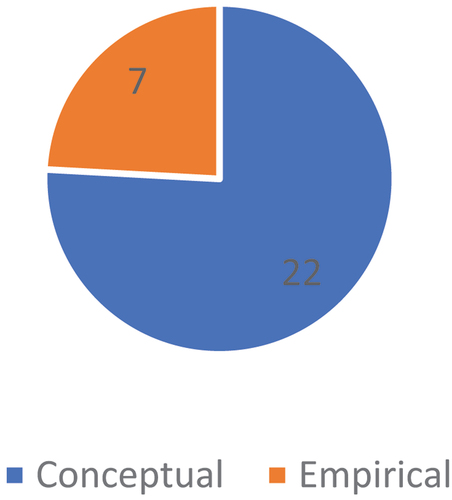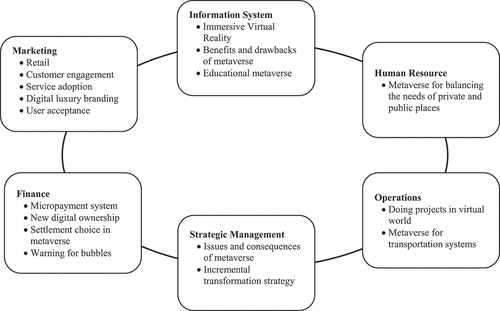Abstract
This study reviews metaverse literature related to the business discipline. Our first search yielded 323 papers, further filtered based on predefined standards. Accordingly, since our research focuses on the metaverse of business, we limited the Scopus search results by choosing only two categories: business, management, and accounting, as well as economics, econometrics, and finance. Using the PRISMA flowchart, this study reviewed 29 selected documents published by publication outlets in Scopus. The study reveals that most metaverse-business studies employed qualitative methods and were categorized as conceptual papers because the research is in its infancy. Marketing has become the dominant business area since most studies relate metaverse with various marketing activities. Besides, management information and finance come second and third in the number of publications. This result indicates that through metaverse, businesses can attract new customers, retain existing customers, improve firm operations, and streamline business processes. This study’s novelty is investigating metaverse studies related to business function areas, which is absent in metaverse literature. One limitation of this study is the single database, namely, Scopus. Further study may employ other databases like Web of Science or Google Scholar. Besides, future studies may explore more metaverse studies concerning more specific topics, such as accounting, auditing, and banking.
1. Introduction
The terminology of metaverse was first mentioned in the early 1990s by Neal Stephenson in his novel, titled Snow Crash. The term comprises of prefix “meta,” which means virtuality, and “verse,” which means the world (Wu & Ho, Citation2022). Using augmented and virtual reality technology, the metaverse can expand the physical world by enabling people to interact naturally in actual and simulated surroundings using avatars and holograms (Dwivedi et al., Citation2022). This paper aims to review the literature on metaverse related to the business by employing a systematic literature review (SLR) technique using the Preferred Reporting Items for Systematic Reviews and Meta-Analyses (PRISMA) flowchart (Page et al., Citation2021).
Metaverse has been predicted to be popular in the future, for it will change the digital transformation landscape. In the past, other supporting technologies were not available or insufficient, so the metaverse gained little attention from many people (Matsubara & Oguchi, Citation2010). However, today’s giant technology companies in several countries have invested much money in being geared up with this technology. For instance, Facebook reportedly spent ten billion US dollars in 2021 to start this metaverse business (Isaac, Citation2021). Besides, the South Korean government reportedly invested around $177.1 million US dollars, making it among the first countries to enter the metaverse emerging business (Keane, Citation2022).
Although the primary subject area of the metaverse is computer science (e.g., Cho et al., Citation2022; S. Choi et al., Citation2022), with the earliest work performed by Dionisio et al. (Citation2013), numerous metaverse studies have also been found in other fields, such as education (e.g., Akour et al., Citation2022; Kye et al., Citation2021; Suh & Ahn, Citation2022), medicine (e.g., Almarzouqi et al., Citation2022; Skalidis et al., Citation2022) and arts (e.g., Baía Reis & Ashmore, Citation2022; H. K. Lee et al., Citation2022; Strutt, Citation2022). Furthermore, bibliometric or review studies on metaverse have also been conducted in a few previous studies (Abbate et al., Citation2022; Dincelli & Yayla, Citation2022; Garavand & Aslani, Citation2022; Petrigna & Musumeci, Citation2022; Shen et al., Citation2021; Wu & Ho, Citation2022). Besides, guidelines for performing bibliometric studies have also been documented in several previous studies (Donthu et al., Citation2021; Mukherjee et al., Citation2022).
The literature review studies on metaverse are mainly within the health or medical context, such as applying metaverse for prevention and treatment (Petrigna & Musumeci, Citation2022). Their study is almost similar to the study by Garavand and Aslani (Citation2022), only that those authors emphasize the impact-wise of the metaverse rather than its challenges. Besides, in a review study on metaverse application for acute medicine, Wu and Ho (Citation2022) posit that the integration of Augmented reality (AR) and virtual reality (VR) has a wide range of applications in medical education and clinical training. In addition to health settings, a review study on metaverse has been conducted in a marketing context to explore metaverse studies concerning virtual advertisement (Shen et al., Citation2021). Nonetheless, these studies do not relate metaverse with business function areas, as employed in this current study. Thus, business-metaverse review studies are still underexplored, resulting in a theoretical gap that needs to be addressed (Lim, Citation2022).
Setiawan et al. (Citation2022) conducted a review study closest to ours, connecting metaverse and business. The study by Setiawan et al. (Citation2022) discusses the essential factors that the metaverse offers to business entities. However, that study does not merge metaverse with business functions commonly available in corporation settings. Thus, our study differs from Setiawan et al. (Citation2022) because we emphasize metaverse studies and evaluate them based on business functions a company commonly operates.
This study contributes to the literature in several ways. First, the present study evaluates the metaverse scholarly work using a business perspective, providing state of the art connecting metaverse technology and business function areas in a corporate setting. Second, this current study provides an avenue for future research by analyzing the current trend of metaverse research, primarily on the research methods and types. Third, our study maps the metaverse-business studies using business function areas, providing the literature gaps for future studies to tap into. Finally, our study is expected to benefit academia by providing a comprehensive portrayal of metaverse literature seen from business function areas. Based on that explanation, this current study attempts to answer the following research questions (RQ):
RQ 1: What is the current state of metaverse studies related to business?
RQ 2:What research methods, types, and business functional areas were used by previous metaverse studies related to business?
The remainder of the paper is organized into four sections to achieve the aim and answer the research questions. Section 2 briefly explains the systematic literature review, while section 3 presents the methods used in the study. Results and discussion are presented in section 4. Finally, the conclusion, limitations, and recommendations are shown in section 5.
2. Systematic literature review
Systematic literature review (SLR) is a research technique that allows academics and practitioners to get a structured and organized picture of what has been published in particular literature throughout the observed years (Milian et al., Citation2019). Researchers in any field commonly use this technique to obtain a portrayal of a particular topic and a literature gap. By conducting an SLR study, researchers can find the niche to be addressed because the most-researched and less-researched topics or sub-topics will emerge. Besides, researchers can develop knowledge and add insights into academic debates.
In addition to SLR, some other review techniques are popular among researchers, including bibliometric analysis. The bibliometric analysis aims to find patterns and links between authors, institutions, keywords, and citations by examining the bibliographic data of a large group of publications. The bibliometric analysis differs from SLR since it is usually performed using particular software, such as VOSviewer, created and developed by van Eck and Waltman (Citation2010). Literature review studies using this software are numerous in various fields and disciplines (e.g., Chang et al., Citation2022; Dosso & Aysan, Citation2022; Firmansyah & Faisal, Citation2020; Firmansyah et al., Citation2020; Tepe et al., Citation2022; Özdemir & Selçuk, Citation2021). Another well-accepted software for bibliometric review study is the Bibliometrix package in the biblioshiny application of RStudio (e.g., Alshater et al., Citation2021; Chandra et al., Citation2022; Dervi et al., Citation2022). Combining this two software can also help better identify, analyze, and synthesize pertinent literature on a particular topic (Thomas & Gupta, Citation2021).
3. Material and methods
This systematic literature review explores how metaverse has been studied in the literature, primarily related to business. To do so, we first performed the literature review protocol and literature screening. Subsequently, content analysis is also performed to reveal some related-content materials, namely, adopted research methods, research types, and document types based on main business functional areas (finance, operations, human resources, marketing, and information systems). The procedure in this current study is explained below to maintain transparency and boost replicability in future studies (Kraus, Breier, et al., Citation2022).
3.1. Literature review protocol
This study employs data from the Scopus database using the keyword “metaverse” in the fields of the document title. Scopus database is used because it is one of the most prominent and trusted databases for scientists. Besides, it has a reliable updating frequency (daily) and extensive coverage from various fields, disciplines, and publication slots (Joshi, Citation2016). Some review studies conducted earlier employ Scopus as a single database in their review (e.g., Ali & Bashir, Citation2022; Alshater et al., Citation2022; Ha et al., Citation2020; Lim, Kumar, & Ali, Citation2022; Lim, Kumar, Pandey, et al., Citation2022).
The search for documents was conducted on 14 September 2022. Thus, other searches conducted after or before this date may result in a different number of search results. Our search result does not limit the publication year, document type, source title, publication stage, keyword, country, and source type because the literature of metaverse is considered in its infancy. Thus, not-performing in those criteria is expected to produce more documents to be investigated. The following is the final search string used in the Scopus database: TITLE (Metaverse) AND (LIMIT-TO (SUBJAREA, “BUSI”) OR LIMIT-TO (SUBJAREA, “ECON”)).
Our initial search results in 323 documents that then be filtered using specific criteria. Since our study focuses on metaverse concerning business, we filtered Scopus by selecting only two subject areas, namely, Business, Management and Accounting, as well as Economics, Econometrics and Finance. These subject areas are the closest ones to the research purpose of our study. The review approach in this study follows the PRISMA framework, which is popular among researchers, including in business research (e.g., Lim & Rasul, Citation2022; Nik Abdullah et al., Citation2022). This procedure following the PRISMA framework is shown in Figure .
3.2. Literature screening
The two subject areas selected in our search produce 34 documents included for further processing. Since all those 34 documents are already in English, we did not perform English language filtering. In the further screening phase, we excluded the editorial because it is not a research paper and does not include an abstract to be analyzed, resulting in 31 documents. The limitation in scope and exclusion of editorial allows us to study only the relevant documents of a metaverse because we excluded a vast number of documents (n = 292), which are available in other areas, such as computer science, engineering, and mathematics. That figure also indicates that metaverse researchers come from various disciplines, from social to engineering sciences.
The subsequent screening was performed by reading the title and abstract of the 31 documents to produce the eligible and included studies. In this stage, we omitted two more documents because one does not have the abstract and the complete file, while the other is included as a magazine article. Thus, we obtained 29 documents eligible for review. No additional studies are included in this phase because we only focus on the Scopus database using the search string outlined earlier. To sum up, the followings are the exclusion criteria applied in this study:
Not included in Business, Management and Accounting and Economics, Econometrics, and Finance fields of Scopus.
Editorial documents.
Magazine articles.
Articles without abstract and complete files.
From those exclusion criteria, it can also be said that this current study implements the following inclusion criteria. First, to obtain the final set of documents, this study only employs documents in two research areas: Management and Accounting and Economics, Econometrics, and Finance. These areas were selected prior to performing the initial search for the document. Thus, this step allows us to generate documents related to the business setting. Second, this study only includes peer-review documents, namely journal articles, conference proceedings, book chapters, and review papers. These types of documents are selected to ensure the quality of the selected documents for review. Thus, editorial notes and magazine articles are not included in our review. Third, this study only includes documents with accessible abstracts and full papers. Thus, the documents the authors had no access to are not included for review. Those exclusion and inclusion criteria are expected to produce relevant documents following the objectives of this study.
4. Results and discussion
The 29 documents studied in this research are explored and read based on their descriptive characteristics and contents. Table provides the summary of documents used in this study, sorted based on the most cited to the least cited ones, indicating their influence on the scholarly literature of metaverse-business studies. In addition to basic information and citations of the selected papers, Table contains content-analysis results of the study, including the employed method, research type, and business function area. The following sections further outline the description and analysis of Table .
Table 1. Selected documents
4.1. Document type
The documents reviewed in this study are of various types: journal articles, conference papers, review papers, and book chapters. However, as shown in Figure , the journal article is the largest contributor (59%) to the dataset, followed by the book chapter in the second position at 24%. These two types dominate the other document types: conference and review papers, which are only 14% and 3%, respectively. The largest number of journal articles may indicate that metaverse research is developing, and some indexed journals have started to accept papers on this topic, opening opportunities for future studies. Besides, since the nature of the journal involves a peer-review process, it can be said that many metaverse papers are also of high quality.
4.2. Publication slot
The slots publishing metaverse studies as related to business vary. Regarding source or slot of publication, most articles in a single slot are conference papers in a book chapter titled “The Immersive Internet: Reflections on the Entangling of the Virtual with Society, Politics and the Economy” with three documents. “Finance Research Letters,” “International Journal of Information Management,” “Journal of Business Strategy,” and “Lecture Notes in Business Information Processing” each contribute two documents, while the rest only contributes one document each. All slots publishing metaverse studies related to the business are shown in Figure .
4.3. Publication year
The term metaverse became more popular recently when Facebook’s founder, Mark Zuckerberg, announced that Facebook would be changed to Meta to adapt to the meta technology (Newton, Citation2021). However, the term metaverse itself had been available in the academic database long ago, in 2000, as documented by Kobryn (Citation2000). The number of research using the word metaverse has grown in the past twenty years, including the ones with the business setting, reaching the maximum number in 2022 with 16 publications (55%), as shown in Figure . This year’s record stating metaverse research was in line with the year of metaverse announcement by Mark Zuckerberg. The publications in the previous years are fewer than it was in 2022. The number of metaverse studies is predicted to increase in 2023 and beyond.
4.4. Content analysis
4.4.1. Adopted research method
The documents in our dataset use three types of research methods. As Figure specifies, most documents in our study employ the qualitative method (80%), followed by quantitative and mixed methods of 17% and 3%, respectively. The qualitative research method, for instance, has been used by Belk et al. (Citation2022) to investigate the motivations behind why some customers pay exorbitant sums of money for digital art with limited intellectual rights. They arguably added that the metaverse may change digital ownership because people’s consumption is now digital and virtual. Furthermore, some qualitative studies proposed frameworks, such as the service quality in 3D internet (Gadalla et al., Citation2013) and micropayment (Kappe & Steurer, Citation2010). In addition, a study on the assessment model of the metaverse for sustainable transportation was presented to highlight the significant effect of the metaverse on future transportation systems (Pamucar et al., Citation2022).
According to our observation, the qualitative method is commonly used by research on relatively new topics where secondary data are unavailable. Whenever the secondary data are already available, researchers may utilize them in their research using quantitative approaches, such as using statistical tools to test hypotheses or find relationships. Since the metaverse is relatively new, we found that many previous studies mainly use qualitative methods.
4.4.2. Document by research type
Regarding research type, most of the studies in our dataset are conceptual papers (76%), meaning that most previous studies do not perform empirical analysis and produce empirical evidence. Only 24% of papers in our metaverse dataset performed empirical research. This condition is understandable because the metaverse is a developing topic, and the secondary data related to this topic for performing empirical research is limited. As a comparison, when Covid−19 first happened, most research papers used conceptual papers using various qualitative methods. However, as time passed by and Covid−19 started to spread worldwide, many researchers then used secondary data and performed empirical research, such as using stock market data for researching Covid−19 impact on the stock market (e.g., Chowdhury et al., Citation2021; Hong et al., Citation2021; Liu et al., Citation2020; Singh et al., Citation2020; Wang & Liu, Citation2022). Figure depicts the composition of conceptual and empirical papers in the dataset of this study.
4.4.3. Document by business function area
The business comprises several common functional areas: finance, marketing, human resources, operations, information system, and strategic management. To map the dataset based on those business functional areas, this study employs content analysis to shedding light on the focus of metaverse research related to business. As shown in Figure , most of the documents in the dataset of this study are categorized in the marketing area (45%), in line with the study conducted by Dwivedi et al. (Citation2022). The second and third ranks are information systems (26%) and finance (14%). Each of the operations and strategic management papers only contributes around 7%, while the human resource paper has the most negligible contribution of 3%.
Based on our dataset, we found that marketing has been the most dominant business function in metaverse-business studies. It is because metaverse mainly deals with various marketing activities, such as retailing (Bourlakis et al., Citation2009; Gadalla et al., Citation2013; Swilley, Citation2016), customer engagement (Hollensen et al., Citation2022), service adoption (S. G. Lee et al., Citation2011), digital luxury branding (Joy et al., Citation2022) and user acceptance for Metaverse (U. K. Lee & Kim, Citation2022). This result implies that the metaverse significantly impacts how a company treats or relates with its customers. Thus, a company must be ready to embrace metaverse technology if it plans to pioneer in delighting customers.
Our dataset’s second largest business function is the information system (IS). The IS-related findings of this study consist of two categories. First, this study documents that metaverse-business studies are bibliometric analyses and systematic reviews aiming to map the metaverse information. For instance, Dincelli and Yayla (Citation2022) analyzed the literature on immersive Virtual Reality (VR) to provide a comprehensive view of companies’ opportunities and difficulties and potential future research areas for the IS discipline. Besides, Abbate et al. (Citation2022) conducted the first bibliometric review on metaverse, providing information about the most influential scientific papers and journals, the most productive authors, organizations, and countries. Another systematic review paper by Smaili and de Rancourt-Raymond (Citation2022) revealed the benefits and potential drawbacks of the metaverse. They also demonstrate that any company may be exposed to metaverse dangers. Therefore, they offer firms techniques to ward off, spot, and avoid fraud and reputational hazards resulting from the metaverse. In addition to the systematic review of the Metaverse, IS-related metaverse studies deal with educational settings such as metaverse-enabled Learning Spaces for improving the teaching-learning process (Marmaridis & Griffith, Citation2009), transformational impact of metaverse (Dwivedi et al., Citation2022) and introductory of immersive internet concept (Huvila, Citation2013; Power & Teigland, Citation2013).
The third most significant contributor to the dataset based on the business function area is the finance area, with four documents. The first finance study in the dataset is the study by Kappe and Steurer (Citation2010), attempting to outline the layout of a micropayment system suitable for virtual worlds. That early study reveals that many virtual worlds have already adopted the concept and used the built-micropayment system. Furthermore, a recent study by Belk et al. (Citation2022) discussed the theoretical and practical issues of the new digital ownership due to the acceptance of the metaverse, proposing the possibility of fractional ownership and fractionalized property rights. On the other hand, Nakavachara and Saengchote (Citation2022) attempted to investigate whether settlement choice (unit of account) affects willingness to pay in the metaverse. They found that cryptocurrency used in the metaverse affects the willingness to pay because that crypto was appreciated following the meta-announcement by Mark Zuckerberg. Finally, a finance-related paper was performed by Vidal-Tomás (Citation2022), presenting some characteristics of 129 play-to-earn tokens and 84 metaverse tokens while documenting the bubble indication, which should be continuously monitored and aware of by investors.
The next business areas are strategic management and operations, contributing minorly to the dataset. The metaverse study related to strategic management was performed by Hirsch (Citation2022), discussing various issues and consequences that the metaverse brings into our lives. These changes result from technological innovations that humans regularly create in society. Another study on strategic management examined whether Facebook’s announcement to change to Meta is a radical business model or incremental transformation (Kraus, Kanbach, et al., Citation2022). They reveal that the movement of Facebook is considered an incremental transformation and not a radical change, aiming at improving the company’s image and signaling corporate change.
In the operations area, we found that a study by Owens et al. (Citation2011) is among the first to investigate how metaverse technology capabilities affect group dynamics and performance in completing a project. They reveal that completing all or a portion of projects in a virtual world (such as the metaverse) is feasible and opens up new possibilities for work collaboration and management. Besides, an operations-related study by Pamucar et al. (Citation2022) proposes four alternatives brought by metaverses on changing transportation systems. These include the self-driving algorithm using artificial intelligence, safety and operations of public transportation, traffic management, and sustainable transportation through sharing economy. Finally, in the human-resource area, we found a study by Calongne et al. (Citation2013), proposing that the metaverse can balance the needs of private and public places. Besides, they highlight how individuals and societies can learn and obtain benefits from social and global communications.
All those business areas documented in our dataset imply that the metaverse has tapped various aspects of lives and merged with business. Besides, business scholars from various fields have also paid attention to this-surging technology. Therefore, based on the discussions in this subsection, this study proposes the following framework depicting the current studies on metaverse related to the business field. This framework, shown in Figure , is expected to add to the literature on metaverse related to a business environment. Besides, it is expected to add an understanding of the current research trend of metaverse-business scholarly works.
5. Conclusion, implications, and limitations
5.1. Conclusion
This study reviews the metaverse literature related to business. Using the PRISMA framework on the Scopus database, this study captures the studies on metaverse trends based on document types, slots publishing metaverse studies, and publication year. Specifically, our research reveals that journal articles are the most found category. Besides, most of them employ qualitative research methods and utilize conceptual approaches. These results might result from the circumstance where the metaverse is still in its infancy.
Furthermore, using a content-analysis approach, this study presents the adopted documents, research types, and documents by business function area on metaverse studies. Through this approach, the marketing area was found to be the most used context by metaverse researchers. Furthermore, this study proposes a framework depicting the current metaverse studies related to business. This framework is expected to be the novelty of this study, adding to the literature of metaverse with a specific approach to the business field, while previous studies did not tap into it.
5.2. Implications
Based on the results of this study, some implications can be drawn. First, marketing managers must leverage metaverse technology in their programs, such as promotion, customer relationship management, and customer engagement. Through the metaverse, businesses can attract new customers and retain existing customers, primarily tech-savvy millennials. Second, the managers in other business functions areas may also use metaverse to improve their operations and streamline business processes, considering that metaverse has been adopted by various companies and documented in previous studies utilizing context in various business areas. Third, future researchers may utilize the results from this study to perform further metaverse-business studies, primarily researching underexplored topics, such as metaverse in finance and operations contexts.
5.3. Limitations
This study is not free from limitations. First, it only employs a single database, namely, Scopus. Further studies may use other databases, such as Web of Science, Google Scholar, PubMed, and Crossref, to generate more search results with different publication quality. Combining those databases is also possible to obtain more diverse results. Besides, using the less-prestigious indexing bodies may allow for more up-to-date documents because their publication criteria are not strict as the slots indexed in Scopus. Second, further studies may limit the document types to only journal articles because this study includes various types. Selecting only journal articles may allow the focus on the peer-review slots. Third, the originality of this study lies in its investigation of business-related metaverse studies, which contribute to the literature on metaverse studies. Thus, future studies need to examine the metaverse concerning even more specialized subjects like accounting, auditing, and banking. Finally, future studies may employ other SLR protocols, such as the SPAR−4-SLR protocol (Paul et al., Citation2021), to gain new insight into metaverse-business research. Alternatively, a bibliometric study on the metaverse-business function area might also be conducted to generate an insightful overview using a different approach from our current study.
Disclosure statement
No potential conflict of interest was reported by the author(s).
Additional information
Funding
References
- Abbate, S., Centobelli, P., Cerchione, R., Oropallo, E., & Riccio, E. (2022). A first bibliometric literature review on metaverse. 2022 IEEE Technology and Engineering Management Conference: Societal Challenges: Technology, Transitions and Resilience Virtual Conference, TEMSCON EUROPE 2022, 254–20. https://doi.org/10.1109/TEMSCONEUROPE54743.2022.9802015
- Akour, I. A., Al-Maroof, R. S., Alfaisal, R., & Salloum, S. A. (2022). A conceptual framework for determining metaverse adoption in higher institutions of gulf area: An empirical study using hybrid SEM-ANN approach. Computers and Education: Artificial Intelligence, 3, 100052. https://doi.org/10.1016/j.caeai.2022.100052
- Alcantara, A. C., & Michalack, D. L. (2023). The metaverse narrative in the matrix resurrections: A semiotic analysis through costumes. Springer Series in Design and Innovation, 25, 260–268. https://doi.org/10.1007/978-3-031-09659-4_20
- Ali, A., & Bashir, H. A. (2022). Bibliometric study on asset pricing. Qualitative Research in Financial Markets, 14(3), 433–460. https://doi.org/10.1108/QRFM-07-2020-0114
- Almarzouqi, A., Aburayya, A., & Salloum, S. A. (2022). Prediction of user’s intention to use metaverse system in medical education: A hybrid SEM-ML learning approach. IEEE Access, 10, 43421–43434. https://doi.org/10.1109/ACCESS.2022.3169285
- Alshater, M. M., Hassan, M. K., Khan, A., & Saba, I. (2021). Influential and intellectual structure of Islamic finance: A bibliometric review. International Journal of Islamic & Middle Eastern Finance & Management, 14(2), 339–365. https://doi.org/10.1108/IMEFM-08-2020-0419
- Alshater, M. M., Saba, I., Supriani, I., & Rabbani, M. R. (2022). Fintech in Islamic finance literature: A review. Heliyon, 8(9), e10385. https://doi.org/10.1016/J.HELIYON.2022.E10385
- Baía Reis, A., & Ashmore, M. (2022). From video streaming to virtual reality worlds: An academic, reflective, and creative study on live theatre and performance in the metaverse. International Journal of Performance Arts and Digital Media, 18(1), 7–28. https://doi.org/10.1080/14794713.2021.2024398
- Belk, R., Humayun, M., & Brouard, M. (2022). Money, possessions, and ownership in the metaverse: NFTs, cryptocurrencies, Web3 and Wild Markets. Journal of Business Research, 153(August), 198–205. https://doi.org/10.1016/j.jbusres.2022.08.031
- Bourlakis, M., Papagiannidis, S., & Li, F. (2009). Retail spatial evolution: Paving the way from traditional to metaverse retailing. Electronic Commerce Research, 9(1–2), 135–148. https://doi.org/10.1007/s10660-009-9030-8
- Calongne, C., Sheehy, P., & Stricker, A. (2013). Gemeinschaft identity in a Gesellschaft metaverse. In The immersive internet: Reflections on the entangling of the virtual with society, politics and the economy (pp. 1–264). Palgrave Macmillan. https://doi.org/10.1057/9781137283023_16
- Chandra, S., Verma, S., Lim, W. M., Kumar, S., & Donthu, N. (2022). Personalization in personalized marketing: Trends and ways forward. Psychology & Marketing, 39(8), 1529–1562. https://doi.org/10.1002/MAR.21670
- Chang, L., Zhang, Q., & Liu, H. (2022). Digital finance innovation in green manufacturing: A bibliometric approach. Environmental Science and Pollution Research, 0123456789(22), 61340–61368. https://doi.org/10.1007/s11356-021-18016-x
- Cho, Y., Hong, S., Kim, M., & Kim, J. (2022). DAVE: Deep learning-based asymmetric virtual environment for immersive experiential metaverse content. Electronics, 11(16), 2604. https://doi.org/10.3390/electronics11162604
- Choi, H. S., & Kim, S. H. (2017). A content service deployment plan for metaverse museum exhibitions—Centering on the combination of beacons and HMDs. International Journal of Information Management, 37(1), 1519–1527. https://doi.org/10.1016/j.ijinfomgt.2016.04.017
- Choi, S., Yoon, K., Kim, M., Yoo, J., Lee, B., Song, I., & Woo, J. (2022). Building Korean DMZ metaverse using a web-based metaverse platform. Applied Sciences, 12(15), 7908. https://doi.org/10.3390/app12157908
- Chowdhury, E. K., Khan, I. I., & Dhar, B. K. (2021). Catastrophic impact of Covid‐19 on the global stock markets and economic activities. Business and Society Review, 127(2), 437–460. https://doi.org/10.1111/basr.12219
- Dervi, U. D., Khan, A., Saba, I., Hassan, M. K., & Paltrinieri, A. (2022). Green and socially responsible finance: Past, present and future. Managerial Finance, 48(8), 1250–1278. https://doi.org/10.1108/MF-11-2021-0561
- Dincelli, E., & Yayla, A. (2022). Immersive virtual reality in the age of the metaverse: A hybrid-narrative review based on the technology affordance perspective. Journal of Strategic Information Systems, 31(2), 101717. https://doi.org/10.1016/j.jsis.2022.101717
- Dionisio, J. D. N., Burns, W. G., & Gilbert, R. (2013). 3D virtual worlds and the metaverse: Current status and future possibilities. ACM Computing Surveys, 45(3), 1–38. https://doi.org/10.1145/2480741.2480751
- Donthu, N., Kumar, S., Mukherjee, D., Pandey, N., & Lim, W. M. (2021). How to conduct a bibliometric analysis: An overview and guidelines. Journal of Business Research, 133, 285–296. https://doi.org/10.1016/J.JBUSRES.2021.04.070
- Dosso, M., & Aysan, A. F. (2022). The technological impact in finance: A bibliometric study of fintech research. Eurasian Studies in Business and Economics, 22, 193–209. https://doi.org/10.1007/978-3-030-94672-2_12
- Dwivedi, Y. K., Hughes, L., Baabdullah, A. M., Ribeiro-Navarrete, S., Giannakis, M., Al Debei, M. M., Dennehy, D., Metri, B., Buhalis, D., Cheung, C. M. K., Conboy, K., Doyle, R., Dubey, R., Dutot, V., Felix, R., Goyal, D. P., Gustafsson, A., Hinsch, C., Jebabli, I. … Wamba, S. F. (2022). Metaverse beyond the hype: Multidisciplinary perspectives on emerging challenges, opportunities, and agenda for research, practice and policy. International Journal of Information Management, 66(July), 102542. https://doi.org/10.1016/j.ijinfomgt.2022.102542
- Firmansyah, E. A., Alamanda, A. R., & Santoso, T. (2020). An evaluation of scholarly works in Zakat: A bibliometric analysis of Islamic economics journals in Indonesia. Amwaluna: Jurnal Ekonomi Dan Keuangan Syariah, 4(2), 311–323. https://ejournal.unisba.ac.id/index.php/amwaluna/article/view/5607
- Firmansyah, E. A., & Faisal, Y. A. (2020). Bibliometric analysis of Islamic economics and finance journals in Indonesia. Al-Muzara’ah, 7(2), 17–26. https://doi.org/10.29244/jam.7.2.17-26
- Gadalla, E., Keeling, K., & Abosag, I. (2013). Metaverse-retail service quality: A future framework for retail service quality in the 3D internet. Journal of Marketing Management, 29(13–14), 1493–1517. https://doi.org/10.1080/0267257X.2013.835742
- Garavand, A., & Aslani, N. (2022). Informatics in medicine unlocked metaverse phenomenon and its impact on health: A scoping review. Informatics in Medicine Unlocked, 32(May), 101029. https://doi.org/10.1016/j.imu.2022.101029
- Gursoy, D., Malodia, S., & Dhir, A. (2022). The metaverse in the hospitality and tourism industry: An overview of current trends and future research directions. Journal of Hospitality Marketing & Management, 31(5), 527–534. https://doi.org/10.1080/19368623.2022.2072504
- Ha, C. T., Thao, T. T. P., Trung, N. T., Huong, L. T. T., Dinh Van, N., & Trung, T. (2020). A bibliometric review of research on STEM education in ASEAN: Science mapping the literature in Scopus database, 2000 to 2019. Eurasia Journal of Mathematics, Science and Technology Education, 16(10), em1889. https://doi.org/10.29333/EJMSTE/8500
- Hirsch, P. B. (2022). Adventures in the metaverse. Journal of Business Strategy, 43(5), 332–336. https://doi.org/10.1108/JBS-06-2022-0101
- Hollensen, S., Kotler, P., & Opresnik, M. O. (2022). Metaverse – the new marketing universe. Journal of Business Strategy, 44(3), 119–125. https://doi.org/10.1108/JBS-01-2022-0014
- Hong, H., Bian, Z., & Lee, C.-C. (2021). COVID-19 and instability of stock market performance: Evidence from the U.S. Financial Innovation, 7(1), 12. https://doi.org/10.1186/s40854-021-00229-1
- Huvila, I. (2013). Sorting out the metaverse and how the metaverse is sorting us out. In The immersive internet: Reflections on the entangling of the virtual with society, politics and the economy (pp. 192–203). Palgrave Macmillan UK. https://doi.org/10.1057/9781137283023_17
- Isaac, M. (2021). Meta’s move to the metaverse drags down profit - the New York Times. The New York Times. https://www.nytimes.com/2022/02/02/technology/meta-facebook-earnings-metaverse.html
- Jeon, J. E. (2021). The effects of user experience-based design innovativeness on user– metaverse platform channel relationships in South Korea. Journal of Distribution Science, 19(11), 81–90. https://doi.org/10.15722/jds.19.11.202111.81
- Joshi, A. (2016). Comparison between Scopus & ISI web of science. Journal Global Values, VII(1), 1–11. https://www.researchgate.net/publication/318258303_COMPARISON_BETWEEN_SCOPUS_ISI_WEB_OF_SCIENCE
- Joy, A., Zhu, Y., Peña, C., & Brouard, M. (2022). Digital future of luxury brands: Metaverse, digital fashion, and non-fungible tokens. Strategic Change, 31(3), 337–343. https://doi.org/10.1002/jsc.2502
- Kappe, F., & Steurer, M. (2010). The Open Metaverse Currency (OMC) – A Micropayment Framework for Open 3D Virtual Worlds. E-Commerce and Web Technologies. In Lecture Notes in Business Information Processing (Vol. 61, pp. 97–106). Springer. 978-3-642-15208-5. https://doi.org/10.1007/978-3-642-15208-5_9
- Keane, J. (2022). South Korea’s investment in the metaverse could provide a blueprint. CNBC-Future Tech Asia. https://www.cnbc.com/2022/05/30/south-koreas-investment-in-the-metaverse-could-provide-a-blueprint.html
- Kobryn, C. (2000). Architectural patterns for metamodeling: The hitchhiker’s guide to the UML metaverse. Lecture Notes in Computer Science (Including Subseries Lecture Notes in Artificial Intelligence & Lecture Notes in Bioinformatics), 1939, 497–497. https://doi.org/10.1007/3-540-40011-7_36
- Kozinets, R. V. (2022). Immersive netnography: A novel method for service experience research in virtual reality, augmented reality and metaverse contexts. Journal of Service Management, 34(1), 100–125. https://doi.org/10.1108/JOSM-12-2021-0481
- Kraus, S., Breier, M., Lim, W. M., Dabić, M., Kumar, S., Kanbach, D., Mukherjee, D., Corvello, V., Piñeiro-Chousa, J., Liguori, E., Palacios-Marqués, D., Schiavone, F., Ferraris, A., Fernandes, C., & Ferreira, J. J. (2022). Literature reviews as independent studies: Guidelines for academic practice. Review of Managerial Science, 16(8), 2577–2595. https://doi.org/10.1007/s11846-022-00588-8
- Kraus, S., Kanbach, D. K., Krysta, P. M., Steinhoff, M. M., & Tomini, N. (2022). Facebook and the creation of the metaverse: Radical business model innovation or incremental transformation? International Journal of Entrepreneurial Behaviour & Research, 28(9), 52–77. https://doi.org/10.1108/IJEBR-12-2021-0984
- Kye, B., Han, N., Kim, E., Park, Y., & Jo, S. (2021). Educational applications of metaverse: Possibilities and limitations. Journal of Educational Evaluation for Health Professions, 18, 2022. https://doi.org/10.3352/jeehp.2021.18.32
- Lee, U. K., & Kim, H. (2022). UTAUT in Metaverse: An “Ifland” case. Journal of Theoretical & Applied Electronic Commerce Research, 17(2), 613–635. https://doi.org/10.3390/jtaer17020032
- Lee, H. K., Park, S., & Lee, Y. (2022). A proposal of virtual museum metaverse content for the MZ generation. Digital Creativity, 33(2), 79–95. https://doi.org/10.1080/14626268.2022.2063903
- Lee, S. G., Trimi, S., Byun, W. K., & Kang, M. (2011). Innovation and imitation effects in metaverse service adoption. Service Business, 5(2), 155–172. https://doi.org/10.1007/s11628-011-0108-8
- Lim, W. M. (2022). The art of writing for premier journals. Global Business and Organizational Excellence, 41(6), 5–10. https://doi.org/10.1002/JOE.22178
- Lim, W. M., Kumar, S., & Ali, F. (2022). Advancing knowledge through literature reviews: ‘What’, ‘why’, and ‘how to contribute. The Service Industries Journal, 42(7–8), 481–513. https://doi.org/10.1080/02642069.2022.2047941
- Lim, W. M., Kumar, S., Pandey, N., Rasul, T., & Gaur, V. (2022). From direct marketing to interactive marketing: a retrospective review of the journal of research in interactive marketing. Journal of Research in Interactive Marketing, 17(2), ahead-of–print. https://doi.org/10.1108/JRIM-11-2021-0276
- Lim, W. M., & Rasul, T. (2022). Customer engagement and social media: Revisiting the past to inform the future. Journal of Business Research, 148, 325–342. https://doi.org/10.1016/J.JBUSRES.2022.04.068
- Liu, H., Wang, Y., He, D., & Wang, C. (2020). Short term response of Chinese stock markets to the outbreak of COVID-19. Applied Economics, 52(53), 5859–5872. https://doi.org/10.1080/00036846.2020.1776837
- Marmaridis, I., & Griffith, S. (2009). Metaverse Services: Extensible Learning with Mediated Teleporting into 3D Environments. Information Systems: Modeling, Development, and Integration. In Lecture Notes in Business Information Processing (Vol. 20, pp. 229–239). 978-3-642-01112-2. https://doi.org/10.1007/978-3-642-01112-2_24
- Matsubara, M., & Oguchi, M. (2010). Evaluation of metaverse server in a widely-distributed environment. Proceedings of the 2010 International Conference on the Move to Meaningful Internet Systems, 307–316. https://dl.acm.org/doi/10.5555/1948509.1948579
- Milian, E. Z., Spinola, M. D. M., & Carvalho, M. M. D. (2019). Fintechs: A literature review and research agenda. Electronic Commerce Research and Applications, 34(February), 100833. https://doi.org/10.1016/j.elerap.2019.100833
- Mukherjee, D., Lim, W. M., Kumar, S., & Donthu, N. (2022). Guidelines for advancing theory and practice through bibliometric research. Journal of Business Research, 148, 101–115. https://doi.org/10.1016/J.JBUSRES.2022.04.042
- Nakavachara, V., & Saengchote, K. (2022). Does unit of account affect willingness to pay? Evidence from metaverse LAND transactions✰. Finance Research Letters, 49(May), 1–8. https://doi.org/10.1016/j.frl.2022.103089
- Newton, C. (2021). Mark Zuckerberg is betting Facebook’s future on the metaverse. The Verge. https://www.theverge.com/22588022/mark-zuckerberg-facebook-ceo-metaverse-interview
- Nik Abdullah, N. H., Krishnan, S., Mohd Zakaria, A. A., & Morris, G. (2022). Strategic management accounting practices in business: A systematic review of the literature and future research directions. Cogent Business & Management, 9(1). https://doi.org/10.1080/23311975.2022.2093488
- Owens, D., Mitchell, A., Khazanchi, D., & Zigurs, I. (2011). An empirical investigation of virtual world projects and metaverse technology capabilities. The Data Base for Advances in Information Systems, 42(1), 74–101. https://doi.org/10.1145/1952712.1952717
- Özdemir, M., & Selçuk, M. (2021). A bibliometric analysis of the International Journal of Islamic and Middle Eastern Finance and Management. International Journal of Islamic & Middle Eastern Finance & Management, 14(4), 767–791. https://doi.org/10.1108/IMEFM-06-2020-0277
- Page, M. J., McKenzie, J. E., Bossuyt, P. M., Boutron, I., Hoffmann, T. C., Mulrow, C. D., Shamseer, L., Tetzlaff, J. M., Akl, E. A., Brennan, S. E., Chou, R., Glanville, J., Grimshaw, J. M., Hróbjartsson, A., Lalu, M. M., Li, T., Loder, E. W., Mayo-Wilson, E., McDonald, S. … Moher, D. (2021). The PRISMA 2020 statement: An updated guideline for reporting systematic reviews. BMJ, 372. https://doi.org/10.1136/bmj.n71
- Pamucar, D., Deveci, M., Gokasar, I., Tavana, M., & Köppen, M. (2022). A metaverse assessment model for sustainable transportation using ordinal priority approach and Aczel-Alsina norms. Technological Forecasting and Social Change, 182(April), 121778. https://doi.org/10.1016/j.techfore.2022.121778
- Paul, J., Lim, W. M., O’Cass, A., Hao, A. W., & Bresciani, S. (2021). Scientific procedures and rationales for systematic literature reviews (SPAR-4-SLR). International Journal of Consumer Studies, 45(4), O1–O16. https://doi.org/10.1111/IJCS.12695
- Petrigna, L., & Musumeci, G. (2022). The metaverse: A new challenge for the healthcare system: A scoping review. Journal of functional morphology and kinesiology, 7(3), 63. https://doi.org/10.3390/jfmk7030063
- Power, D., & Teigland, R. (2013). Postcards from the metaverse: An introduction to the immersive internet. In The Immersive Internet: Reflections on the Entangling of the Virtual with Society, Politics and the Economy (pp. 1–12). Palgrave Macmillan UK. https://doi.org/10.1057/9781137283023_1
- Sartamorn, S., & Oe, H. (2022). Metaverse marketing for community development Revitalization of traditional industrial sectors in Thailand. Springer Proceedings in Business and Economics, 121–126. https://doi.org/10.1007/978-3-031-06581-1_16
- Setiawan, K. D., & Anthony, A. (2022). The Essential Factor of Metaverse for Business Based on 7 Layers of Metaverse - Systematic Literature Review. Proceedings of 2022 International Conference on Information Management and Technology, ICIMTech 2022, August, 687–692. https://doi.org/10.1109/ICIMTech55957.2022.9915136
- Shen, B., Tan, W., Guo, J., Zhao, L., & Qin, P. (2021). Applied sciences How to promote user purchase in metaverse? A systematic literature review on consumer behavior research and virtual commerce application Design. Applied Sciences, 11(23), 1–29. https://doi.org/10.3390/app112311087
- Singh, B., Dhall, R., Narang, S., & Rawat, S. (2020). The outbreak of COVID-19 and stock market responses: An event study and panel data analysis for G-20 countries. Global Business Review, 0972150920957274. https://doi.org/10.1177/0972150920957274
- Skalidis, I., Muller, O., & Fournier, S. (2022). CardioVerse: The cardiovascular medicine in the era of Metaverse. Trends in cardiovascular medicine. https://doi.org/10.1016/j.tcm.2022.05.004
- Smaili, N., & de Rancourt-Raymond, A. (2022). Metaverse: Welcome to the new fraud marketplace. Journal of Financial Crime. https://doi.org/10.1108/JFC-06-2022-0124
- Strutt, D. (2022). A simple tool for remote real-time dance interaction in virtual spaces, or “dancing in the metaverse. Critical Stages, (25), 1–18. https://www.critical-stages.org/25/a-simple-tool-for-remote-real-time-dance-interaction-in-virtual-spaces-or-dancing-in-the-metaverse/
- Suh, W., & Ahn, S. (2022). Utilizing the Metaverse for learner-centered constructivist education in the post-pandemic era: An analysis of elementary school students. Journal of Intelligence, 10(1), 17. https://doi.org/10.3390/jintelligence10010017
- Swilley, E. (2016). Moving Virtual Retail into Reality: Examining Metaverse and Augmented Reality in the Online Shopping Experience. In Looking Forward, Looking Back: Drawing on the Past to Shape the Future of Marketing (pp. 675–677). Springer. https://doi.org/10.1007/978-3-319-24184-5_163
- Tepe, G., Geyikci, U. B., & Sancak, F. M. (2022). FinTech companies: A bibliometric analysis. International Journal of Financial Studies, 10(1), 2. https://doi.org/10.3390/ijfs10010002
- Thomas, A., & Gupta, V. (2021). Tacit knowledge in organizations: bibliometrics and a framework-based systematic review of antecedents, outcomes, theories, methods and future directions. Journal of Knowledge Management, 26(4), 1014–1041. https://doi.org/10.1108/JKM-01-2021-0026
- van Eck, N. J., & Waltman, L. (2010). Software survey: VOSviewer, a computer program for bibliometric mapping. Scientometrics, (84), 523–538. https://doi.org/10.1007/s11192-009-0146-3
- Vidal-Tomás, D. (2022). The new crypto niche: NFTs, play-to-earn, and metaverse tokens. Finance Research Letters, 47(PB), 102742. https://doi.org/10.1016/j.frl.2022.102742
- Wang, Q., & Liu, L. (2022). Pandemic or panic? A firm-level study on the psychological and industrial impacts of COVID-19 on the Chinese stock market. Financial Innovation, 8(1), 36. https://doi.org/10.1186/s40854-022-00335-8
- Wu, T., & Ho, C. B. (2022). Australasian emergency care a scoping review of metaverse in emergency medicine. Australasian Emergency Care, xxxx, 26(1), 75–83. https://doi.org/10.1016/j.auec.2022.08.002

